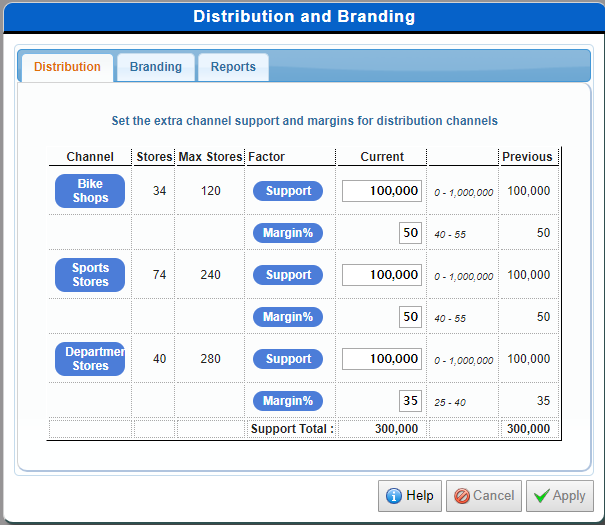What is Distribution?
Distribution (place) relates to the ability of the firm to make products accessible to its target segments. This is achieved through distribution channels – in this case through retail outlets.
The number of stores in the channel that decide to stock your products will depend on the retail price, margin, unit sales history, and extra support offered. You must specify what margin and what extra support you are going to offer the retailers in each channel.
What is Retail Margin and Extra Support ($)?
The retailer margin decision refers to the percentage of the retail price that the retailer keeps. So don’t increase it too much! Example, if your bike is priced at $1,000 and your retail margin is 40%, then the wholesale price that you receive for each bike is only $600.
Maintaining existing distributors and acquiring new ones require considerable resources. Extra Support (e.g. in terms of special promotions and discounts) costs are required to enable product training of retailers and providing promotional literature.
Distribution costs vary based on the number of stores that currently stock your products.

Vendors of bikes can be broken into three categories:
- Bike Shops
- Department Stores
- Sports Stores
(Note: Sports Stores are only available in Multi-Player in MikesBikes Advanced)
Your challenge is to decide how to set price and distributor retail margins in order to influence your distribution coverage in a way that results in either increased market share or increased profit.
Distribution Index
Your distributors look at how much total retail margin they make from stocking all of your products and based on this they decide how many stores will stock your products. This then translates into a Distribution Index which ranges from 0 to 1 (higher is better). In general as your distributors make more money from selling your products, then more stores will stock them and your Distribution Index will increase.
Example of Distributor Behavior
Note: The market segments all have medium sensitivity to Distribution apart from the Commuter segment, which has low sensitivity to distribution (see the Market Information report under the Key Reports menu).
For instance, if you sold 10,000 bikes at $1000 with a 50% retail margin, then your distributors would make 10,000 * 50% * $1000 = $5 million
Perhaps you dropped your price to $900, and your retail margin to 45% you can now sell 12,000 units. Your distributors would then make 12,000 * 45% * $900 = $4.86 million
In this case, your Distribution Index would fall slightly as your distributors made less retail margin in total. This may not be an issue in the Commuter market, but it may disadvantage you in the other market segments. Of course, it also depends on your competitors’ actions. If your competitors have much higher distribution indexes than you, then you will lose more market share.
As you can see, sales volume is also an important component of distribution. So it may be beneficial to keep retail margins slightly higher whilst building initial market share for new products. It may be possible to gradually reduce margins once you have established products with high sales volumes without adversely affecting your Distribution Index.

